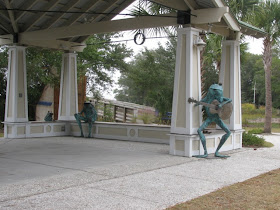 |
| I think this one was secretly coveting my sub sandwich. |
 |
| Here is the fogged in beach. |
 |
| Standing on the harbor shore at Fort Johnson looking across to Fort Sumter. |
 |
| I love the south, you have palm trees and live oaks. Palm trees mean warm weather, yeah. |
...
 |
| The Yorktown Aircraft Carrier is on display in Charleston Harbor. |
 |
| This battery, Battery Huger, inside Fort Sumter, was built in the late 1898 for the Spanish American War. It never saw use. |















Great report on the forts, Judy. I've seen some of them but not as many as you did. I gave my sis-in-law a link to your blog as she's interested in visiting some battlefields on the mainland. She and hubby (Don's brother) live in Hawaii.
ReplyDelete